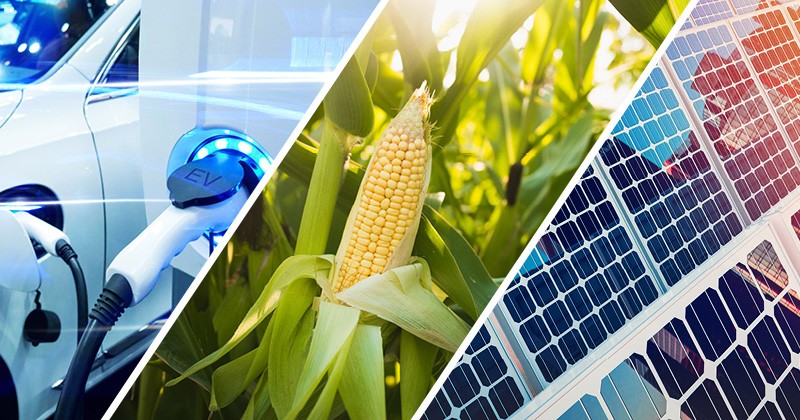Delaware Energy Institute announces grants for multi-disciplinary research projects at UD
When it comes to supporting research, timing is everything.
Robust, early support is crucial for scientific inquiry to gain momentum and have a chance to make an impact. Seed grants, in particular, can enable scientists to leverage early success to gain support for future research funding opportunities.
To that end, the Delaware Energy Institute (DEI) has announced funding awards totaling over $650,000 for three energy-focused research projects at the University of Delaware. Comprising a dozen faculty members from across four different colleges, the projects will kickstart an effort to create foundations for new, interdisciplinary energy programs at UD.
“We’re thrilled to support this critical research and help bring great minds together,” said Allie Sethman, deputy director of DEI. “Demand for new technologies is high, and with it comes a demand for new ideas. Collaboration is absolutely essential in pushing energy and sustainability research into these new spaces. Investing in these ideas now will not only help UD faculty in preparation for future opportunities, but also unite our efforts to tackle society’s biggest energy challenges.”
The DEI-funded projects will investigate questions spanning a broad array of energy topics, including smart cities and urbanization, food production, energy harvesting and more.
Smarter cities
Andreas Malikopoulos, the Terri Connor Kelly and John Kelly Career Development Associate Professor in Mechanical Engineering, will lead a team focusing on expanding research of emerging mobility systems (such as connected and automated vehicles, as well as shared mobility), which have been shown to reduce energy consumption and alleviate traffic congestion in specific scenarios.
“One key question that still remains unanswered is, how can we develop an energy-efficient mobility system that can enhance accessibility, control the ratio of travel demand over capacity, and ultimately improve the overall well-being of our cities?” said Malikopoulos. “Our goal is to directly address this question.”
Food production and energy
Cristina Archer, professor in the College of Earth, Ocean and Environment, will lead her team to examine the understudied links between food items and the energy used to produce them, an essential question given the prevalence of food waste, population growth, and threats to agricultural systems from global warming and pollution.
“About a third of the energy consumed by humanity, directly or indirectly, is related to food,” Archer said. “Yet the waste and potential inefficiencies of the energy used for food are relatively unknown. This gap is an opportunity for UD to become a leading institution to focus specifically on energy-food links.”
Harvesting sunlight
While sunlight arriving at earth contains more than enough energy to meet the needs of the entire planet, harvesting that energy efficiently is another matter altogether. Because the light arriving from the sun comes in many different colors, conventional photovoltaics can never convert more than 33% of the energy into useable electrical power. Current technical solutions to this problem are too expensive to be economically viable.
College of Engineering associate professor and UD Nanofabrication Facility Director Matthew Doty and his research team aim to change the current thinking on how photons of different colors are harvested, with the goal of enabling economically-viable approaches to high-efficiency solar energy conversion.
“Photons from the sun arrive with many different colors and energies,” Doty said. “For example, blue photons have more energy than red photons. This wide range of incident photon energies creates fundamental limits to the efficiency of energy harvesting. Similar limits apply to all solar energy harvesting devices, including photocatalytic materials used for water splitting or chemical fuel generation. Our projects will change the way photons of different colors are directed to solar cells optimized for each color and will convert two or more low-energy photons (e.g. red) into one high-energy photon (e.g. blue). These advances will provide new technical capabilities that we can employ to address the challenge of a sustainable energy future for our planet.”
The full list of projects and faculty include:
The Energy Footprint of Food
Lead investigator: Cristina Archer, Professor, College of Earth, Ocean and Environment
Co-investigators:
Pinki Mondal, assistant Professor, College of Earth, Ocean and Environment
Keith W. Goossen, professor, College of Engineering
Hong Li, associate professor, College of Agriculture and Natural Resources
Summary: To develop a new metric, called the Energy Footprint of Food (EFF), that summarizes all energy types and their amounts needed per unit of food, including direct, indirect, and wasted energy; to create a set of flexible and transparent methods for calculating the EFF for all food types; and to provide a comprehensive, public, geospatial dataset of EFF in the U.S.
Center for Energy-Efficient Sociotechnical Systems (CEESS)
Lead investigator: Andreas Malikopoulos, Terri Connor Kelly and John Kelly Career Development Associate Professor, College of Engineering
Co-investigators:
Philip Barnes, assistant professor, College of Arts and Sciences
Lena Mashayekhy, assistant professor, College of Engineering
Mark Nejad, assistant professor, College of Engineering
Timothy Vickery, assistant professor, College of Arts and Sciences
Summary: To establish a center that will aim to integrate technological, social, and institutional dimensions for energy-efficient mobility systems in smart cities.
Rethinking Photon Harvesting
Lead investigator: Matt Doty, associate professor, College of Engineering
Co-investigators:
Joshua Zide, professor, College of Engineering
Stephanie Law, assistant professor, College of Engineering
Summary: Develop new metasurfaces that can efficiently guide photons from separate wavelength bands into different channels, allowing for more cost-efficient multi-junction photovoltaics. Develop new materials that can convert two low-energy photons into a single high-energy photon, allowing us to “recycle” photons below the bandgap of a host solar cell or host photocatalyst into photons that can be used.
About DEI
The Delaware Energy Institute was established in 2008 to provide a focal point for energy-related activities at UD and to marshal and expand the University’s science, engineering and public policy expertise in new and emerging energy technologies. The Institute’s strengths include catalysis, photovoltaics, hydrogen generation and storage, fuel cells, biofuels, wind energy, nanomaterials and high-efficiency solar.
To learn more about DEI, visit dei.udel.edu.

